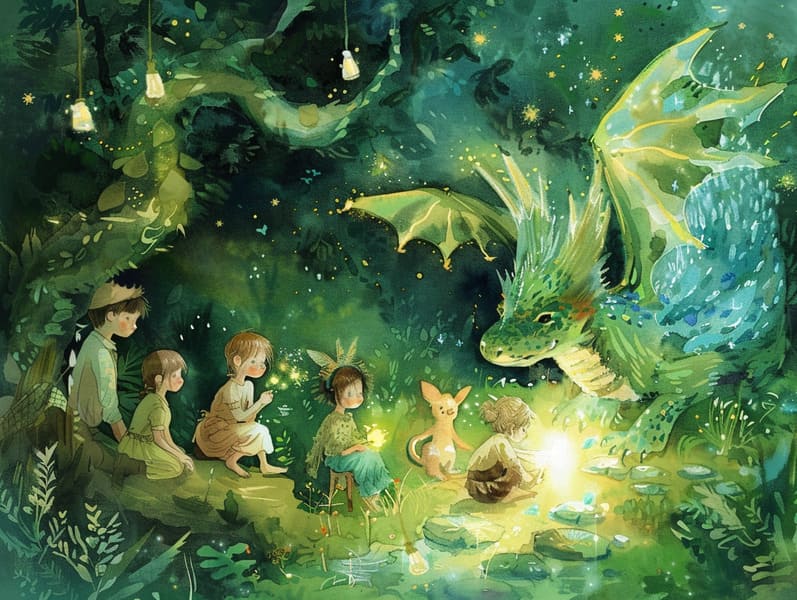
Traditional fairy tales have long histories. These tales have been told from one generation to the next ages before they were ever written down. They originated from a variety of civilizations, including Western traditions. They were initially disseminated among elders, often carrying themes and messages relevant to the societal norms and beliefs of the time.
Jacob and Wilhelm Grimm, Jacob and Wilhelm (the Grimm brothers), were among the first to collect many of these beloved tales. Their published works, "Grimm's Fables," included tales like "Ashenputtel," "The Bread Crumb Trail," and "Little Snow White," which have since become mainstays in the world of beloved fairy tales. Similarly, Andersen's delightful narratives, such as "The Mermaid's Tale," and "The Duckling that Could," have touched hearts worldwide, cementing their place in the pantheon of beloved fairy tales.
Though they are centuries old, these tales remain as impactful as ever, especially as kids' bedtime tales. These fantastical tales are now available in various formats, including gorgeously illustrated books, enchanting animations, and digital storybooks.
Their continued relevance can be attributed to several captivating elements:
Ethical Lessons: Traditional fairy tales often offer important moral lessons. Narratives like "The Boy Who Cried Wolf" teach the benefit of being truthful, while "The Tortoise and the Hare" underline the virtues of persistence and modesty. These narratives offer young ones clear distinctions between good and bad, helping to shape their moral compass in a kind yet lasting way.
Kindness and Comprehension: Timeless fairy tales frequently involve figures facing obstacles and hardships, motivating young readers to empathize with their struggles and rally behind their triumphs. For instance, "Beauty and the Beast" shows us the merit of looking past the exterior to perceive the true being of a individual, enhancing kindness and discernment.
Cultural Recognition: Many old fairy tales are interwoven with the cultural contexts from which they originated. Discovering these tales can provide intriguing perspectives into different heritages, encouraging a sense of cultural appreciation and awareness.
Fantasy and Imagination: The extraordinary elements in old fairy tales—magic wands—awaken children’s innovative ideas. These fairy tales transport readers to supernatural realms, stimulating inventive ideas and a sense of curiosity that lasts a lifetime.
Classic fairy tales are not only fantastical but also enlightening. They work as fantastical tools in promoting various cognitive and emotional skills in young ones. When ancient fairy tales are spoken out loud, they nurture verbal skills by introducing new language items and detailed sentence structures. This practice also strengthens listening skills and attentiveness, as young ones focus on every detail, ready to see what happens next.
Furthermore, analyzing the themes and characters of timeless fairy tales can develop thinking skills and problem-solving abilities. Kids are shown to find patterns, make predictions, and grasp cause and effect. These analyses also contribute to children awesome site articulate their thoughts and feelings, boosting their emotional intelligence.
In today’s electronic age, the accessibility of digital fairy tales has made these stories more reachable than ever. Online platforms and software share broad selections of children's fairy tales that can be accessed or listened through anytime, anywhere. Fairy tales narrated are particularly favored, giving an fascinating method for little ones to be a part of these delightful tales. Audio stories and read-aloud videos bring characters and settings to life, often enhanced by magical melodies and soundtracks that enrich the storytelling experience.
The persistent attraction of classic fairy tales lies in their ability to shift to modern days while keeping hold of their core messages. Contemporary takes of these narratives often present more multicultural characters and modern settings, making them relevant to today’s audience. However, the main ideas of courage, sympathy, and lawfulness remain unchanged, continuing to appeal to audiences of all ages.
Fairy tales also offer a sense of protection and familiarity. They yield a tidy narrative with a definite beginning, middle, and end, often ending with the wrap-up of conflicts and the triumph of morality over immorality. This consistency can be calming for little ones, rendering a sense of invariability in an constantly changing world.
Timeless fairy tales continue to enchant and instruct new generations, maintaining their mystique and meaningfulness in modern society. As children's night stories, they offer a perfect blend of charm and enlightenment, nurturing moral values, empathy, and creativity. The existence of internet fairy tales and the sought after status of fairy tales told out loud ensure that these old fairy tales remain acquirable to new generations.
By holding onto and disseminating these fairy tales, we continue to laud the rich tapestry of fables and cultural heritage. Whether you are discovering a vibrantly illustrated book, perusing a virtual library, or playing an voice book, the captivation of popular fairy tales is always within reach. These tales convey of the unwavering presence of storytelling and its ability to draw us together across centuries and lands.
Even if you are accessing a beautifully illustrated book, viewing a online library, or listening on an audiobook, the loveliness of Grimm's fairy tales is always within reach.
These fairy tales reveal of the unending impact of storytelling and its ability to unite us across eras and regions, establishing a link that fascinates and enlightens alike.